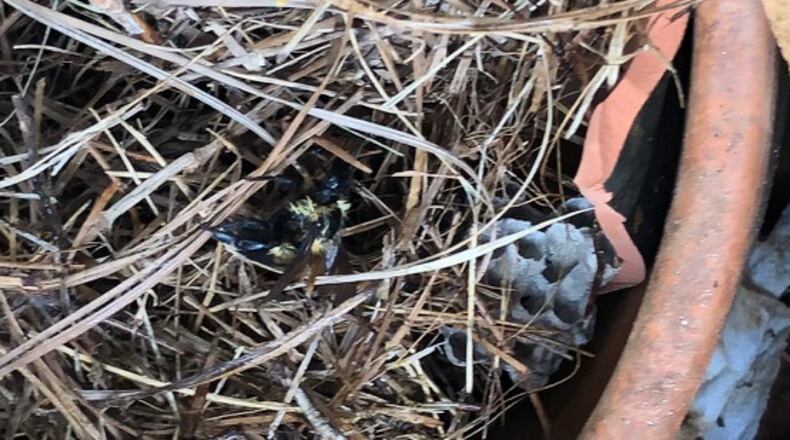Q: What are these insects? They are smaller than bumblebees; they chase me and they attack like a hornet or yellow jacket! I’ve been around bumblebees in the yard and they seem so docile flying around. Is it because I’m near their nest? They make nests in the straw in my broken pots and in my birdhouses. Bill Powers, email
A: I think we have a problem of identification. The docile bees that follow you around are carpenter bees. The small bees that nest in straw or old bird nests are bumblebees. Both are in the bee family (Apidae), but carpenter bees are in the genus Xylocopa and bumblebees are in the genus Bombus. They are not the same. Carpenter bees live and overwinter in the holes they have made in wood. There are two species of carpenter bees in Georgia, but there are 17 species of bumblebees here. As you found out, some of them are much more aggressive than carpenter bees. You already know two places where bumblebees might be found; I suggest you avoid them. If you have to eliminate a nest, an insecticidal dust works well because it sticks to their hairy bodies.
Q: I had new Zenith zoysia sod installed five weeks ago and it is doing well. However, the neighborhood landscape maintenance company mistakenly aerated and spread fescue seed on my yard two days ago! What is the best course of action to eliminate the fescue? Is it too soon to apply a preemergent due to it harming the new zoysia? Roy Hobbs, Dawson County
A: The mode of action for all of the common preemergent chemicals is to inhibit the growth of root cells. Since you have lots of growing cells in the roots of the young zoysia sod, I recommend that you not apply any chemicals. Rather, commit to mowing the zoysia regularly at the recommended height of 2 inches. Fescue hates being mowed that low. If you mow regularly, the fescue will die.
Q: I have two large beds of cast iron plants that have a lot of dead leaves from cold damage over the last two winters. If I cut them all down now, will it kill them or will they come back this year? Steve Preston, email
A: It would’ve been better to cut everything back in March. I think cutting the plants to the ground this late in spring is a bad idea. Prune out all of the upright brown leaves, but keep all of the green leaves to feed the roots while they are producing new foliage.
Email Walter at georgiagardener@yahoo.com. Listen to his occasional garden comments on “Green and Growing with Ashley Frasca” Saturday mornings on 95.5 WSB. Visit his website, walterreeves.com, or join his Facebook page at bit.ly/georgiagardener for his latest tips.
About the Author
The Latest
Featured

